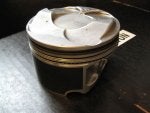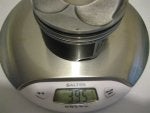This thing torn-down is an absolute masterpiece!
The sump acts as a girdle, there are three oil-squirters per hole cooling and lubing the pistons from the bottom and it is a direct-injection petrol motor! This basically means that it has a 2-stage fuel-pump system that delivers petrol in there at some 1,700 PSI! (Versus 40-45 pounds on a more conventional setup, to completely mist the fuel and shoot it right onto the tops of the pistons like a diesel - also cooling the charge - and eliminating knock)!
(Versus 40-45 pounds on a more conventional setup, to completely mist the fuel and shoot it right onto the tops of the pistons like a diesel - also cooling the charge - and eliminating knock)!
This is how they get away with an 11.25:1 compression motor that will run on standard pump gas and never ping! Unfortunately Alfa also chose to do their own short-block iteration and bring the bore down from the 3.6 litre's base design at 94mm for the other versions of the same "High Feature" / "Global" "Alloytec" design, to an 89mm bore for a 3.2 litre displacement, but they managed to keep the initial power-rating...) The headers are crap and the heads stand to gain a great deal, but we mainly have to get the displacement back!
They all utilize an 85.6mm stroke and basically we'll start the big-bore offerings of these motors for the street by simply bringing the bore back up to 94mm, or 95mm for now, but with a compression-bump to 11.7:1. On race applications we'll steal a couple of mm from the connecting-rod big-end journals on the crank (huge 56mm housing) with custom journals and rods, to get a further bump into the 3.8-3.9 litre regions! Even with the standard stroke though, the maximum bore capacity is apparently 4.0 litres from increases to the bore alone!
I smell a 4.2 eventually! For now, I'm working on the piston-design with the usual sources; I'll post pics when they are done! (Not allowed to post engine pics, so don't ask...)
For now, I'm working on the piston-design with the usual sources; I'll post pics when they are done! (Not allowed to post engine pics, so don't ask...)
The sump acts as a girdle, there are three oil-squirters per hole cooling and lubing the pistons from the bottom and it is a direct-injection petrol motor! This basically means that it has a 2-stage fuel-pump system that delivers petrol in there at some 1,700 PSI!
This is how they get away with an 11.25:1 compression motor that will run on standard pump gas and never ping! Unfortunately Alfa also chose to do their own short-block iteration and bring the bore down from the 3.6 litre's base design at 94mm for the other versions of the same "High Feature" / "Global" "Alloytec" design, to an 89mm bore for a 3.2 litre displacement, but they managed to keep the initial power-rating...) The headers are crap and the heads stand to gain a great deal, but we mainly have to get the displacement back!
They all utilize an 85.6mm stroke and basically we'll start the big-bore offerings of these motors for the street by simply bringing the bore back up to 94mm, or 95mm for now, but with a compression-bump to 11.7:1. On race applications we'll steal a couple of mm from the connecting-rod big-end journals on the crank (huge 56mm housing) with custom journals and rods, to get a further bump into the 3.8-3.9 litre regions! Even with the standard stroke though, the maximum bore capacity is apparently 4.0 litres from increases to the bore alone!
I smell a 4.2 eventually!































